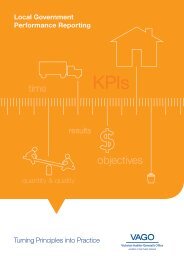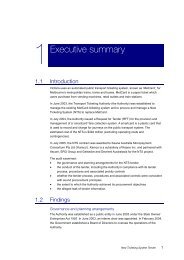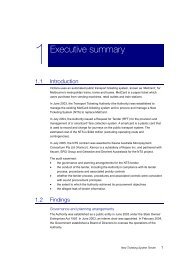Delivering HealthSmart Report - VAGO
Delivering HealthSmart Report - VAGO
Delivering HealthSmart Report - VAGO
Create successful ePaper yourself
Turn your PDF publications into a flip-book with our unique Google optimized e-Paper software.
Achievement against the approved program plan<br />
The final determination of whether the program was implemented in accordance with<br />
the approved budget will need to make these adjustments, taking into account the final<br />
number of implementations of each system by June 2009.<br />
Second, the estimates of agency contributions reported in the above table are only<br />
notional—their actual costs are not tracked centrally by OHIS, nor are they necessarily<br />
separately tracked and monitored by each health agency. The real cost of agency<br />
implementation may therefore vary significantly from the notional costs allowed in the<br />
budget.<br />
For example, through discussions with DHS and health agency staff, our review of<br />
agency business cases for clinical systems confirmed that agency costs are much<br />
higher than the 30 per cent target assumed by DHS.<br />
The four lead agencies for clinical systems are proposing various ‘enabling works’ 5 to<br />
be carried out as part of the system roll-out.<br />
Due to the patient focus of the clinical system, lead agencies are seeking new and/or<br />
upgraded ICT devices that can be used at ‘point-of-care’ so that clinicians will be<br />
encouraged to fully adopt the new technology, and not revert to manual or paperbased<br />
systems after roll-out.<br />
In addition, costs being incurred for training, data migration, change management and<br />
project management are higher than forecast by DHS.<br />
These extra, unforeseen components of the system roll-out are leading to higher than<br />
expected capital and recurrent costs for agencies, which is causing funding pressures,<br />
and hence approval delay.<br />
Further, the lead agency business cases are unable to demonstrate sufficient direct<br />
benefits to their Board from higher investment in clinical systems. This is because most<br />
of the expected benefits such as a reduction in adverse events for patients and the<br />
development of infrastructure for a future state-wide electronic health record accrue<br />
sector-wide, rather than at the individual agency level.<br />
Although the implementation of clinical systems is likely to extend beyond 2009, at<br />
present OHIS has no budgeted figures beyond June 2009. OHIS has advised that it<br />
may need extra funds to complete the full scope of clinical systems implementation.<br />
DHS is currently modelling how much an agency implementation of a HealthSMART<br />
application should cost on a ‘standardised’ basis. This work needs to be completed<br />
quickly to allow the costs of the implementation program to be managed in a<br />
predictable manner by participating agencies.<br />
The final consideration when analysing the cost of the program to date is to determine<br />
its additional net cost to the state budget.<br />
5 Enabling works include updating telecommunication and network infrastructure, purchasing point of<br />
care devices and in some agencies building a single patient master index to integrate multiple patient<br />
administration systems.<br />
<strong>Delivering</strong> HealthSMART — Victoria's whole-of-health ICT strategy 29
















